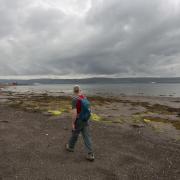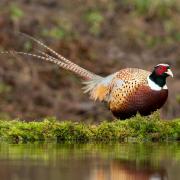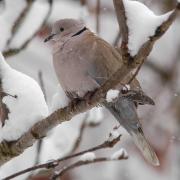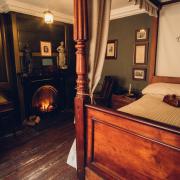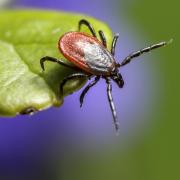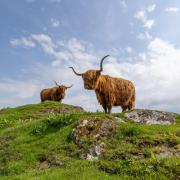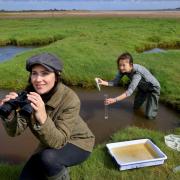Newton Stewart Walking Festival sprang from a traumatic experience for the economy of south west Scotland which was hit by foot and mouth disease in the spring of 2001. The farming industry was faced with the economic and emotional impact of the slaughter of thousands of livestock, but less well known was the impact on the tourism industry.
Visitors were discouraged; as far as possible the countryside was closed down, but tourism businesses received no financial compensation.
An economic recovery plan from Dumfries & Galloway Council, VisitScotland and Dumfries & Galloway Enterprise had a strong emphasis on the development of walking, cycling and wildlife tourism, including the production of walking brochures and the encouragement of community-led walking festivals.
Langholm, Annan, Moffat and Upper Nithsdale were quick to sign up. As the then councillor for Cree Ward, I took a proposal to Newton Stewart Initiative in November 2002 suggesting that Newton Stewart could become the centre for a Galloway walking festival. This was adopted and very quickly implemented.

FIRST FESTIVALS
The Festival started as a sub-committee of Newton Stewart Initiative under the chairmanship of Bob Simpson with support from Forest Enterprise, RSPB, Dumfries & Galloway Tourist Board, and local historians Andy Shankland and Jim McLay.
The first festival was a weekend event in May 2003, with seven easy and moderate walks. One 15km walk from Loch Trool to Stroan Bridge was stewarded but the rest were themed walks at Blackcraig, Wood of Cree, Wigtown Bay Nature Reserve, Knockman, and Newton Stewart town, led by local wildlife and history specialists.
The 2004 festival was more ambitious. With the significant introduction of Galloway Mountain Rescue Team, the 12-walk programme included strenuous walks in the Galloway Hills.
2005 saw the first WalkFest Challenge; sponsorship from Cunningham Outdoor Centre and the introduction of an evening ceilidh. During this early period there was a lot of support from public agencies including the Council and Forestry Commission.

NEXT STEPS
In 2007 the Festival took on a structure and programme which has survived, albeit with many adaptations and innovations, until today.
The committee decided it was time to become a stand-alone organisation, separate from Newton Stewart Initiative, with myself as chair. Support from agencies had been dwindling and the festival committee became a completely volunteer-led group.
The programme expanded to a full seven days with 25 walks, including a Walkfest Challenge from Loch Doon to Bruce’s Stone, a ‘hopscotch’ along three sections of the Southern Upland Way, and a Cruggleton coastal hike. Bookings rose to 343 and the first formal evaluation showed an encouraging response.

WALKFEST
By the 2008 festival Wigtownshire Ramblers began to lead many of the easy and moderate-plus walks. This established a successful partnership: Galloway Mountain Rescue Team taking responsibility for the strenuous hill walks and the Ramblers leading on the lower ground.
The basic structure of WalkFest was established – 26 to 29 guided walks over seven days plus three or four evening events.
Every festival has featured Galloway’s rugged hill ranges – the Awfu’ Hand, Rhins of Kells, and the Minnigaff Hills, with innovative variations. No WalkFest would be complete without the ascent of the ‘Big Hill’ which forms the backdrop to Newton Stewart. But the Galloway Mountain Rescue Team ensured that there was the occasional foray further afield to Screel and Bengairn, Haggis Hill near Straiton, Cairnsmore of Carsphairn and even Criffel near Dumfries in 2015.
Similarly, the programmes of lower ground walks have established many favourites such as the Fleet Valley bluebell woods, the Saints and Sinners cliff-top walk to Isle of Whithorn, Kirroughtree forest trails and Almorness peninsula on the Stewartry’s Solway coast. And year after year, the committee has refreshed the programme by introducing new areas, new routes and new themes.
Different areas have their specialists. The inimitable Bob Peace has introduced hundreds of walks to the varied landscape of the Glenkens; Richard Kay has done the same for the Cree Valley; Dave McNicol has explored Cairnsmore of Fleet from every angle.
Improvements to access have opened up new routes, especially along the Rhins coast.

The emphasis has always been on showcasing Galloway in all its diversity. The leaders are local people, knowledgeable and enthusiastic, while the experience for many walkers has been enhanced by the inclusion of themed walks with expert guides.
Since 2011 Andy Nicholson, the regional archaeologist, has shared his passion for the landscapes of the past; Tim Stephenson from Creetown Gem Rock Museum has revealed the secrets of the underlying geology at numerous festivals. We have called on the expertise of Anna Johnston in the Stewartry National Scenic Areas; David Steel on Cally Estate, and Nic Coombey from Solway Firth Partnership. We’ve had photographic walks with Keith Ratcliffe; birdwatching in Wood of Cree with RSPB, and three overnight walks, from 2016-2018, celebrating Galloway Forest’s Dark Sky Park status in the company of an astronomer. Walks at Bagbie have provided insights into the farming scene.
We have themed whole festivals, sometimes following VisitScotland’s themed years. 2022 focused on water (rivers, coasts and lochs); 2018 had a Covenanter theme, leading us to many evocative memorials, and in 2019 we explored drystone dykes. Evening talks picked up the same themes.

Food and drink have increasingly featured, with many of the lower level walks finishing at cafes and pubs. We have drunk coffee from Palnackie to Ballantrae, and many places in between.
In 2015 a Supper Walk was introduced – in fact there were two suppers that year – at Clachan Inn in Dalry and a ‘Pies and Pints’ at Bladnoch Inn. In 2012 we replaced the Friday evening ceilidh with a welcome supper laid on by the Andrews family at the Belted Galloway café, which quickly became a popular mainstay of the programme.
Of course, the Festival has not been without its hiccups, challenges and mistakes. The provision of transport has always been both a selling point and one of the challenges. Stagecoach and later McCullochs have supplied the large vehicles; some of their drivers becoming enthusiastic ambassadors. However, increasingly we have had to rely on minibuses hired from Glenkens Community Transport or Wigtownshire Passenger Transport to tackle forest roads and rough tracks.
Recruiting volunteer drivers has been challenging and ensuring that complicated transport schedules work efficiently is not always easy, especially if walks don’t stick to times.
During the festival week, the base for registration and transport co-ordination becomes the heart of the event. The increasing cost of hiring McMillan Hall in 2014 led to the Belted Galloway generously giving free use of the premises for weekend registration.

WALKING BACK
In 2020, Covid struck, and the 2020 and 2021 festivals were cancelled. With the increasing workload for a small number of people, the strains of advancing years and the effort needed to access funds, there was a distinct possibility that WalkFest would not return.
However, a programme had been prepared for 2020 so we decided to go ahead in 2022. The reaction of our loyal customer base was invigorating. Eager to get back into the countryside, our visitors returned in record numbers full of anticipation. Over the years we have built up a regular clientele and some have attended every festival since 2003.

2022 saw many new visitors, perhaps a result of the post-pandemic interest in UK-based holidays. We eased the workload and expense by stopping the brochure and shifting all bookings online.
Last year brought fresh challenges and we reduced the number of walks and looked for new people to help. Whithorn Trust led a Pilgrim’s Way walk and the National Trust offered a walk at Threave Nature Reserve.
The Mountain Rescue Team increased its involvement, leading some of the less strenuous walks and picking up some minibus driving.
We themed the festival as a Galloway and Southern Ayrshire UNESCO Biosphere event, having gained recognition of its status as an environmentally sustainable event in 2022. Biosphere staff helped with walks and marketing, and we even partnered with Biosphere guide Sarah Redman to offer a wild swim/ walk combination.

FESTIVAL ACHIEVEMENTS
Over the last 22 years we have organised more than 450 guided walks. For a week every May, around 240 individual walkers have explored the hills, forests and coasts of Galloway - terrain, which is not always easy to access as, unlike many popular walking areas, there is a scarcity of waymarked and clear paths. To the residents of Dumfries & Galloway we have offered safe access to the countryside with experienced leaders and the chance to become more familiar with their home patch.
The percentage of visitors has increased in recent years and we now welcome walkers from all over the UK, with a smattering of overseas visitors.
We know that WalkFest has, for many people, been their introduction to Galloway, bringing them back at other times, even when they are no longer fit to participate.
Our extensive feedback shows that we have provided a lot of pleasure to a lot of people: relaxation, fun, challenge and inspiration.
Newton Stewart is now one of the longest-running and largest walking festivals in Scotland. What are the secrets of our success?
1. Since 2007, Walkfest has been run entirely by volunteers, local people passionate about Galloway.
2. We have run to a tight and controlled budget. With no staff to pay, transport has been our main outlay. This financial sustainability has been vital as public sector funding dwindled.
3. The support of the Mountain Rescue Team and Wigtown Ramblers. Over the years we have gained experience, learning the importance of careful planning, reconnaissance and time-keeping.
4. We have constantly refreshed the programme, looking for new routes, new themes and fresh ideas.
5. May was a good choice of timing! Of course we’ve had soakings, low mist, high winds and occasional sleet and snow driving us off the tops but, by and large, we have enjoyed good weather and no midges.
WalkFest 2024 runs from May 10-16 www.walkfestnewtonstewart.com






